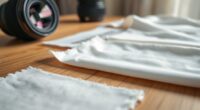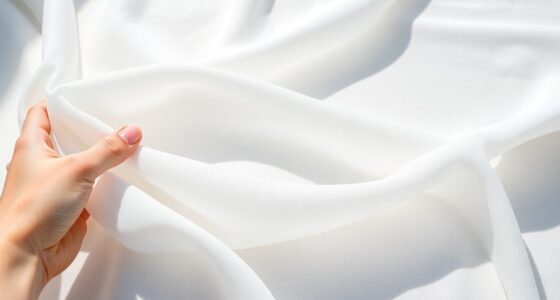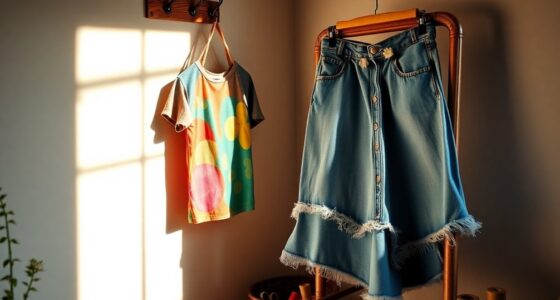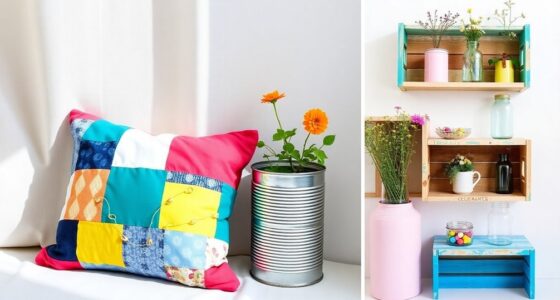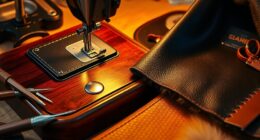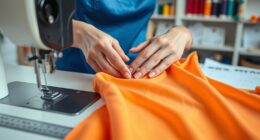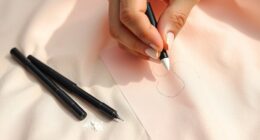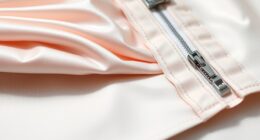Choosing the right needle type and size is key to getting perfect stitches and avoiding fabric damage. For delicate fabrics like silk, use smooth, fine needles; for heavy materials like denim, go for sturdy, larger ones. Regularly inspect and replace worn needles to maintain quality. Matching needle specifications to your fabric guarantees clean, durable results. Keep these tips in mind, and you’ll improve your sewing outcomes every time—there’s more to discover for flawless projects ahead.
Key Takeaways
- Match needle type and size to fabric weight and texture for optimal stitch quality.
- Regularly inspect and replace worn or damaged needles to prevent skipped stitches and fabric damage.
- Use appropriate needle sizes: larger for heavy fabrics, smaller for delicate textiles.
- Choose needles compatible with your sewing machine and maintain them to ensure smooth operation.
- Proper needle selection and maintenance extend machine lifespan and improve overall sewing results.

Choosing the right needle type and size is vital for ensuring safe and effective injections or procedures. When working with fabrics or performing sewing projects, selecting the appropriate needle directly impacts the quality of your stitches and the durability of your finished product. Different fabrics require specific needle types, as some are designed to glide smoothly through delicate materials like silk or chiffon, while others are built to penetrate heavy or dense textiles such as denim or canvas. By understanding fabric compatibility, you can prevent skipped stitches, fabric snags, or puckering, guaranteeing your work looks professional and lasts longer.
In addition to choosing the correct needle for your fabric, paying attention to needle maintenance plays a vital role in achieving the best results. Regularly inspecting your needles for signs of wear or damage, such as burrs or bent points, helps prevent skipped stitches and fabric damage. Proper maintenance involves cleaning and storing needles in a dry, safe place to avoid rust and corrosion, which can compromise their sharpness and performance. Sharp, well-maintained needles not only produce cleaner stitches but also reduce strain on your sewing machine, extending its lifespan. Remember, a dull or damaged needle can cause thread breakage, uneven stitching, or even damage to your fabric, so taking the time to maintain your needles is well worth the effort. Additionally, advances in AI technology are continuously improving the tools available for quality control and precision in sewing and manufacturing processes.
When selecting a needle, consider the size as well. Needle sizes are usually numbered, with smaller numbers indicating thicker, sturdier needles suitable for heavy-duty fabrics, while larger numbers are for finer, delicate materials. For example, a size 90/14 needle is versatile and commonly used for medium-weight fabrics like quilting cotton, whereas a size 70/10 is better suited for lightweight fabrics such as silk or chiffon. Using the correct size reduces tension issues, prevents skipped stitches, and results in more precise, professional-looking seams. If you’re working with multiple layers or thick fabrics, opting for a larger, stronger needle is wise to avoid bending or breaking mid-sew.
Ultimately, understanding fabric compatibility and maintaining your needles properly guarantees your projects turn out beautifully and last over time. It might seem like a small detail, but the right needle choice combined with diligent maintenance makes a significant difference in the quality of your work. Keep an eye on your needles, replace them when needed, and always match your needle type and size to your fabric for the best results. This attention to detail will save you time, frustration, and money, helping you achieve perfect stitches every time.
Frequently Asked Questions
How Do I Choose the Right Needle for Delicate Fabrics?
When choosing a needle for delicate fabrics, you should consider fabric care and needle maintenance. Opt for fine, sharp needles like size 9 or 10 to prevent damage and guarantee smooth stitches. Always check your needle regularly for dullness or burrs, replacing it as needed to maintain fabric integrity. Using the correct needle helps protect delicate fibers, resulting in better sewing results and longer-lasting fabrics.
Can Different Needle Sizes Affect Sewing Speed?
Think of needle size as your sewing speed’s secret partner. When you choose a smaller needle, you tend to sew more delicately, which might slow you down just a tad. Larger needles can boost your sewing speed, making quick work of thicker fabrics. So, yes, different needle sizes can influence your sewing pace—smaller for precision, larger for efficiency—helping you tailor your project to your desired rhythm.
Are Specific Needles Better for Machine Embroidery?
For machine embroidery, specific needles are essential for precision stitching and needle durability. You should choose embroidery needles designed with a sharper point and a larger eye, which help prevent thread breakage and allow smooth fabric movement. These needles improve your stitching quality, reduce skipped stitches, and guarantee your needle lasts longer. Using the right embroidery needle enhances your project’s overall look and efficiency, making your sewing experience more enjoyable and professional.
How Do I Identify a Needle’s Compatibility With My Sewing Machine?
To identify if a needle is compatible with your sewing machine, check its needle shank, which must match your machine’s specified shank type. Also, examine the needle gauge to make sure it’s appropriate for your project—thicker gauges for heavier fabrics, thinner for delicate ones. Always compare these details with your machine’s manual or existing needle to avoid issues and ensure smooth stitching.
What Are the Signs of a Worn or Damaged Needle?
You’ll notice signs of a worn or damaged needle during needle inspection, which can hinder your sewing performance. Look for bent or chipped needles, rough or frayed threads, or skipped stitches. If the needle feels loose or makes unusual noises, replace it immediately. A damaged needle can cause fabric snags, breakage, or uneven stitches, so regular checks guarantee smooth sewing and help you achieve professional results every time.
Conclusion
Choosing the right needle can make all the difference in your sewing projects. Remember, it’s not just about the size or type, but about finding what works best for you. Like a tailor fitting a suit, selecting the perfect needle guarantees your stitches are flawless. Trust your instincts, experiment, and you’ll stitch your way to perfection. After all, as the saying goes, “A chain is only as strong as its weakest link”—so pick your needle wisely for the best results.

